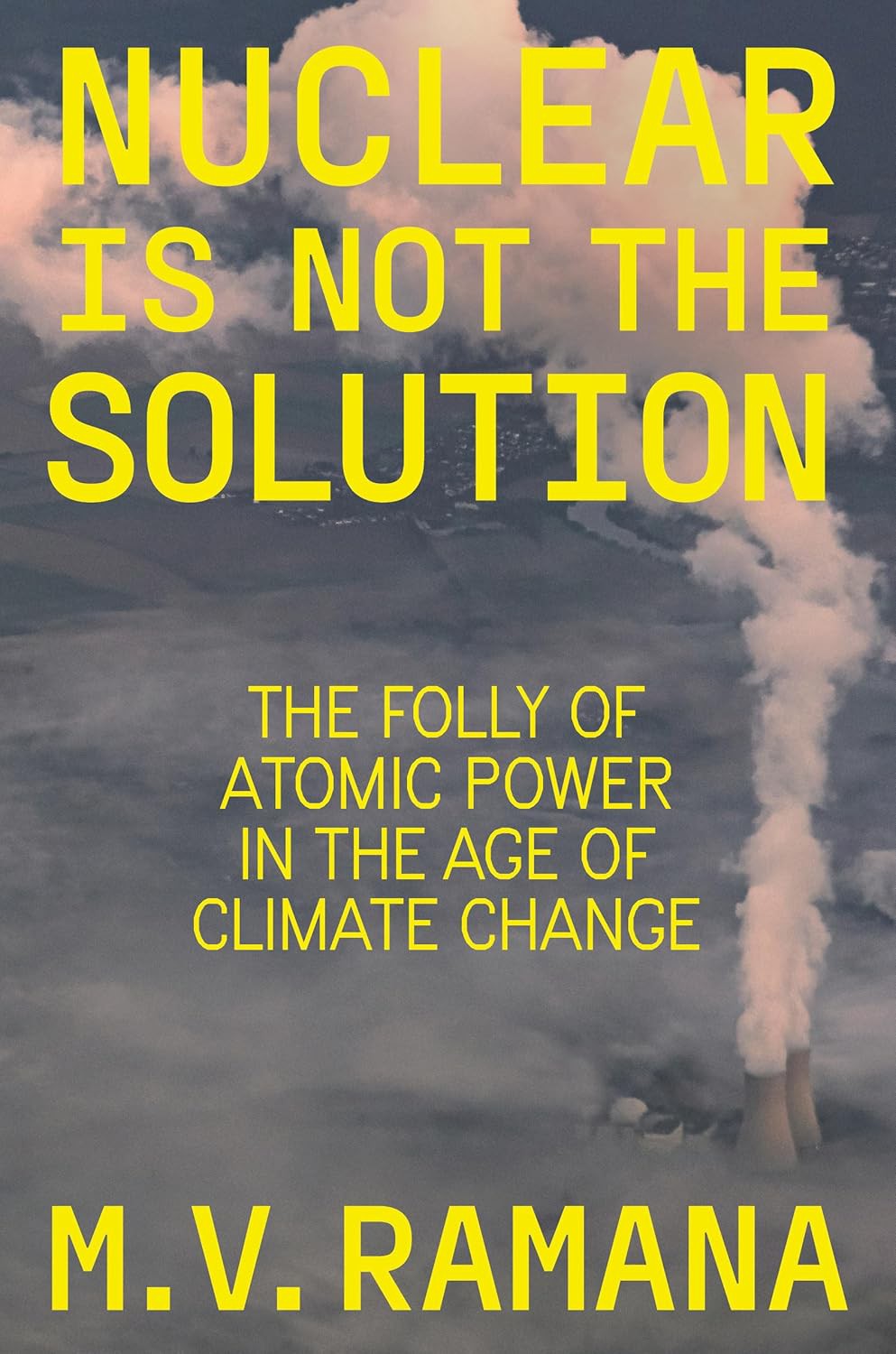
The shimmer of nuclear power seems to be growing brighter of late, ensnaring even those on the left. The Canadian Nuclear Workers Council, invited to present by the Saskatchewan Federation of Labour (SFL) to present at their 2024 convention, extolled the virtues of nuclear; Jacobin Magazine has been moving over to an increasingly pro-nuclear stance within its pages; and Marxist geographer Matthew Huber argues that support for nuclear electricity generation should be a cornerstone of left-wing climate politics. In an article for Catalyst, Huber and Fred Stafford emphasize the “importance of centralized, large-scale reliable power generation like hydroelectric dams and nuclear power, as opposed to decentralized, small-scale, and intermittent forms of power like rooftop solar panels.”
Huber and other pro-nuclear leftists argue that the centralized nature of nuclear is necessary for taking action on climate change and working toward a decarbonized environment; that the workforce for nuclear power in North America is heavily unionized; that nuclear power is more reliable than renewables; that new nuclear technology is safer and cleaner – two big buzzwords in the pro-nuclear world; and that claims of cancer from accidents at nuclear plants like Fukushima and concerns over radioactive waste are exaggerated.
Global nuclear resurgence
This growing nuclear-curiosity within the left is unsurprising given the global resurgence in enthusiasm for nuclear electricity generation over the past decade. As nuclear physicist and professor M.V. Ramana explains in Nuclear is Not the Solution: The Folly of Atomic Power in the Age of Climate Change, capitalist states are increasingly turning to nuclear power in an attempt to reduce carbon emissions and mitigate the climate crisis.
The German government recently reversed its long-standing opposition to using nuclear power as a climate mitigation strategy in European Union legislation and policy. The question of nuclear power’s role in energy transitions was the source of significant conflict between Germany and France, the two largest economies in the European Union. While Germany began phasing out nuclear power after the Fukushima disaster in 2011, France continues to produce 70 per cent of its electricity with nuclear reactors.
"My bottom line is that nuclear energy, whether with old reactor designs or new faux alternatives, will simply not resolve the climate crisis."
The government of Canada has similarly embraced nuclear power as a solution to the climate crisis. In early 2025, Jonathan Wilkinson, then federal minister of energy and natural resources, issued a statement arguing that the environmental concerns associated with nuclear electricity generation “pale in comparison” to the “existential threat posed by climate change.” The federal government has provided generous subsidies to support the development of new small modular reactors. The provinces of Ontario and New Brunswick have likewise invested in the construction of small modular reactors, while governments in Saskatchewan and Alberta have signalled their interest in introducing nuclear power to their energy grids.
Nuclear is not the solution
Ramana’s book cuts through oft-touted claims cited by governments and industry about nuclear power, arguing clearly and convincingly – and for a non-specialist audience – that nuclear cannot and should not drive energy transitions.
“My bottom line is that nuclear energy, whether with old reactor designs or new faux alternatives, will simply not resolve the climate crisis. The threat from climate change is urgent. The world has neither the financial resources nor the luxury of time to expand nuclear power. Meanwhile, even a limited expansion would aggravate a range of environmental and ecological risks. Further, nuclear energy is deeply imbricated in creating the conditions for nuclear annihilation. Expanding nuclear power would leave us in the worst of both worlds.”
According to Ramana, nuclear electricity generation is too costly and too slow to build to significantly reduce atmospheric carbon emissions in a meaningful time frame. Further, he argues that it is a complex, dangerous, and environmentally risky technology that cannot be uncoupled from its ties to nuclear weapons.
Nuclear is Not the Solution makes two broad contributions to public knowledge about nuclear energy and climate change. On the one hand, it critically debunks the notion that nuclear power offers a viable and desirable solution to the climate crisis. On the other, it seeks to explain why states continue to support nuclear power despite all of the problems it poses, highlighting the entanglement between private industry and governments.
An undesirable solution
Ramana argues that nuclear power is an undesirable solution to climate change because of the risks it poses to the environment, human health, and global security. According to Ramana, proponents of nuclear power often argue that large-scale accidents like meltdowns are now impossible and that previous accidents at Chernobyl and Fukushima had minimal impacts on the environment and human health. Pointing to an increase in thyroid cancers following both disasters, he suggests that the effects of these disasters were in fact severe and claims that the possibility of major accidents will remain so long as nuclear power exists. While Ramana acknowledges that the Japanese government has claimed that increases in detected thyroid cancers following Fukushima were due to an increase in screening, he suggests that this points to a deeper issue: it is “nearly impossible to trace any specific cancer to radiation exposure” making it “easy to sow doubts about any relationship between the two.”
The challenges of dealing with radioactive wastes like spent nuclear fuel and uranium tailings are cited as additional risks.
An infeasible solution
Ramana argues that nuclear power is not a feasible solution to the climate crisis because of the high costs and long periods of time required to build and operate new nuclear reactors. The window to effectively mitigate climate change by reducing global carbon emissions grows smaller each day. Ramana demonstrates that new nuclear reactors frequently suffer from (sometimes absurdly long) construction delays and cost overruns.
“The result of these economic and temporal realities is that nuclear power capacity has largely been stagnant, with a falling share of electricity production; this trend will continue into the future. Thus, I conclude, even if one were to ignore the undesirable outcomes associated with nuclear energy, the technology cannot meaningfully contribute to mitigating climate change. Pursuing such false solutions only lowers the chances of dealing with the environmental problems at hand.”
He argues that state intervention into the nuclear industry always unfolds in ways that “allow the owners of capital to make more profits.”
Ramana argues that small modular reactors, thorium reactors, and other emerging technologies reproduce the problems associated with ‘traditional’ reactors: “no reactor design can solve the multiple problems confronting nuclear energy, including high costs, safety, proliferation, and waste.”
Socialized costs and risks
Ramana claims that nuclear power is only profitable because its costs are socialized through a combination of high residential electricity bills and significant public expenditures. Because of government patronage, even nuclear reactors that fail to generate electricity can still produce profits for investors.
In many cases, it is the same corporations profiting from nuclear and fossil fuel electricity generation.
“[C]ompanies view nuclear power as an attractive investment as long as the costs of building and operating nuclear plants are foisted on the pocketbooks of the public, either in the form of higher electricity bills or in the form of taxes, and the multiple environmental and economic risks associated with the technology are socialized.”
He argues that state intervention into the nuclear industry always unfolds in ways that “allow the owners of capital to make more profits.”
“It is not just electricity companies that profit from nuclear power. The list of other corporate interests vested in nuclear power is long: starting from financial ones buying up and selling businesses, to consulting companies offering advice about how to go about building a nuclear plant, to Wall Street banks loaning money, to law firms writing contracts, to insurance companies that take a cut for agreeing to hold part of the bag in the event of an accident.”
In many cases, it is the same corporations profiting from nuclear and fossil fuel electricity generation. As a result, Ramana argues companies with interests in nuclear power often oppose energy transitions and are hostile to the growth of renewables.
The military connection
The close relationship between civilian and military nuclear programs, Ramana argues, explains why so many states continue to finance and politically support nuclear electricity generation. According to Ramana, nuclear power can serve as a “gateway” to military uses because infrastructure, materials, technical expertise, and personnel used in nuclear electricity generation can also be used to produce nuclear weapons.
Instead of nuclear power, Ramana promotes a green energy transition premised on expanding renewables and challenging capitalist inequalities and imperatives for endless growth.
“The connection between nuclear energy and nuclear weapons derives from the fact that any technology capable of enriching uranium-235 from 0.7 percent to 3 percent can further enrich it, even up to the levels of concentration needed to build nuclear weapons. This potential ability to use uranium-enrichment technology for making either nuclear fuel or nuclear weapons materials was the underlying technical reason for concerns about Iran’s centrifuge program.”
He cites the additional examples of India’s and Pakistan’s nuclear weapons programs, where the development of nuclear weapons has relied on the reactors, fuel, and scientific experts associated with their civilian nuclear power programs.
Renewables and capitalist growth
Instead of nuclear power, Ramana promotes a green energy transition premised on expanding renewables and challenging capitalist inequalities and imperatives for endless growth.
He acknowledges that renewables are “no panacea” and that rapidly expanding renewables could come with significant environmental costs, most notably from the extraction of so-called ‘critical’ minerals.
“Absent fundamental changes [in the global distribution of wealth and power], the impacts of the extractive processes associated with any form of electricity generation will only continue to accelerate. Capitalism is based on continuous economic growth. For this continuous economic growth to take place, capitalism needs energy and materials to feed ever-expanding production. But material and energy use cannot keep growing continuously on a finite planet. Renewables might not produce carbon dioxide when they generate power, but they do have their own material requirements.”
He concludes that there are no solutions to the climate crisis that “will allow everything else to stay the same, from the energy we use to the financial structures that govern its production.”
At the end of the day, there is no easy technological fix to the climate crisis. Addressing it will require us to significantly reduce our energy consumption in the Global North. This means not only resisting the siren calls of nuclear power advocates but also radically rethinking the way we live our lives and challenging the growth imperatives of capitalism.






